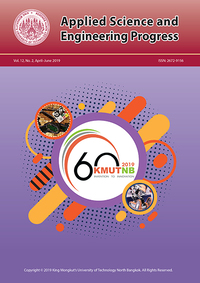Genetic Diversity and Aggressiveness of Bipolaris oryzae in North-Central Thailand
Main Article Content
Abstract
One hundred and ten isolates of Bipolaris oryzae, the causal agent of rice brown spot disease were collected from paddy fields in four provinces of north-central Thailand, including Ang Thong, Chai Nat, Lop Buri, and Sing Buri. DNA polymorphism of some Bipolaris oryzae isolates was determined by VNTR, ISSR and RAPD markers. Only VNTR-MR primer showed different fingerprint patterns among these isolates, therefore this primer was selected to study genetic diversity of the Bipolaris oryzae population. In total, there were three haplotypes corresponding to the results from cluster analysis; each of the three clusters shared identical haplotype. The majority of the isolates were separated into group A (88.18%), indicating predominant asexual reproduction of clonal population. However, there was no relationship between haplotype and either collection provinces or aggressiveness on rice. Among four rice varieties tested, including Khao Dawk Mali 105 (KDML 105), RD31, Pathum Thani 1, and Jao Hom Nin (JHN), JHN was the most resistant variety, while KDML 105 was the most susceptible to brown spot disease.
Article Details
References
[2] M. K. Barnwal, A. Kotasthane, N. Magculia, P. K. Mukherjee, S. Savary, A. K. Sharma, H. B. Singh, U. S. Singh, A. H. Sparks, M. Variar, and N. Zaid, “A review on crop losses, epidemiology and disease management of rice brown spot to identify research priorities and knowledge gaps,” European Journal of Plant Pathology, vol. 136, no. 3, pp. 443–457, Jul. 2013.
[3] S. Y. Padmanabhan, “The great bengal famine,” Annual Review of Phytopathology, vol. 11, pp. 11–24, 1973.
[4] S. Savary, L. Willocquet, F. A. Elazegui, N. P. Castilla, and P. S. Teng, “Rice pest constraints in tropical Asia: Quantification of yield losses due to rice pests in a range of production situations,” Plant Disease, vol. 84, no. 3, pp. 357–369, Mar. 2000.
[5] S. Sunder, R. Singh, and R. Agarwal, “Brown spot of rice: An overview,” Indian Phytopath, vol. 64, no. 3, pp. 201–215, 2014.
[6] J. L. Katara1, H. Sonah, R. K. Deshmukh, R. Chaurasia, and A. S. Kotasthane, “Molecular analysis of QTLs associated with resistance to brown spot in rice (Oryza sativa L.),” Indian Journal of Genetics and Plant Breeding, vol. 70, no. 1, pp. 17–21, Jan. 2010.
[7] R. H. Phelps and C. R. Shand, “Brown leaf spot disease and fertilizer interaction in irrigated rice growing on different soil types,” Nutrient Cycling in Agroecosystems, vol. 42, no. 1, pp. 117–121, Feb. 1995.
[8] H. Sato, K. Matsumoto, C. Ota, T. Yamakawa, J. Kihara, and R. Mizobuchi, “Confirming a major QTL and finding additional loci responsible for field resistance to brown spot (Bipolaris oryzae) in rice,” Breeding science, vol. 65, no. 2, pp. 170–175, Apr. 2015.
[9] B. A. McDonald and C. Linde, “The population genetics of plant pathogens and breeding strategies for durable resistance,” Euphytica, vol. 124, pp. 163–180, 2002.
[10] M. M. Kamal and M. A. T. Mia, “Diversity and pathogenicity of the rice brown spot, Bipolaris oryzae (Breda De Haan) Shoem. in Bangladesh assessed by genetic fingerprint analysis,” Bangladesh Journal of Botany, vol. 38, no. 2, pp. 119–125, Dec. 2009.
[11] M. R. S. Motlagh and M. Anvari, “Genetic variation in a population of Bipolaris oryzae based on RAPD-PCR in north of Iran,” African Journal of Biotechnology, vol. 9, no. 36, pp. 5800–5804, Aug. 2010.
[12] C. V. Castell-Miller and D. A. Samac, “Population genetic structure, gene flow and recombination of Cochliobolus miyabeanus on cultivated wildrice (Zizania palustris),” Plant Pathology, vol. 61, no. 5, pp. 903–914, Jan. 2012.
[13] M. R. G. Burgos, M. L. B. Katimbang, M. A. G. Dela Paz, G. A. Beligan, P. H. Goodwin, I. P. Ona, R. P. Mauleon, E. Y. Ardales, and C. M. Vera Cruz, “Genotypic variability and aggressiveness of Bipolaris oryzae in the Philippines,” Journal of Plant Pathology, vol. 137, no. 2, pp. 415–429, Aug. 2013.
[14] B. Archana, K. R. Kini, and H. S. Prakash, “Genetic diversity and population structure among isolates of the brown spot fungus, Bipolaris oryzae, as revealed by inter-simple sequence repeats (ISSR),” African Journal of Biotechnology, vol. 13, no. 2, pp. 238–244, Jan. 2014.
[15] S. Siripornvisal. (2019, Jan.). Diversity of rice pathogenic fungus, Bipolaris oryzae, and its relationship to the causal of leaf brown spot disease in poor-grade paddy field of Phranakhon Si Ayutthaya Province. Phranakhon Si Ayutthaya Rajabhat University, Phranakhon Si Ayutthaya, Thailand [Online]. Available: http://newtdc.thailis.or.th/docview.aspx?tdcid=8024 (in Thai).
[16] D. S. Manamgoda, A. Y. Rossman, L. A. Castlebury, P. W. Crous, H. Madrid, E. Chukeatirote, and K. D. Hyde, “The genus Bipolaris,” Studies in Mycology, vol. 79, pp. 221–288, Sep. 2014.
[17] S.-Y. Park, S.-H. Jang, S.-O. Oh, J. A. Kim, and J.-S. Hur, “An easy, rapid, and cost-effective method for DNA extraction from various lichen taxa and specimens suitable for analysis of fungal and algal strains,” Mycobiology, vol. 42, no. 4, pp. 311–316, Dec. 2014.
[18] T. J. White, T. D. Bruns, S. B. Lee, and J. W. Taylor, “Amplification and direct sequencing of fungal ribosomal RNA genes for phylogenetics,” in PCR Protocols: A Guide To Methods and Applications, San Diego, CA: Academic Press, 1990, pp. 315–322.
[19] P. D. Bridge, D. A. Pearce, A. Rivera, and M. A. Rutherford, “VNTR derived oligonucleotides as PCR primers for population studies in filamentous fungi,” Letters in Applied Microbiology, vol. 24, no. 5, pp. 426–430, 1997.
[20] A. Ahmadpourabc, C. Castell-Millerd, M. Javan-Nikkhahb, M. R. Naghavie, F. P. Dehkaeif, Y. Lenga, K. D. Puria, and S. Zhonga, “Population structure, genetic diversity, and sexual state of the rice brown spot pathogen Bipolaris oryzae from three Asian countries,” Plant Pathology, vol. 67, no. 1, pp. 181–192, 2018.
[21] S. H. Ou, Rice Diseases, 2nd ed. Kew, England: Commonwealth Mycological Institute, 1985.
[22] T. W. Mew, H. Leung, S. Savary, C. M. Vera Cruz, and J. E. Leach, “Looking ahead in rice disease research and management,” Critical Reviews in Plant Sciences, vol. 23, no. 2, pp. 1–25, 2004.


